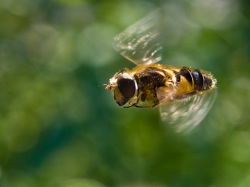German airports use honeybees to sniff out air quality

If you are at an airport in Germany and see honeybees flying around, don’t worry. The bees have been enlisted as “biodetectives” to inspect air pollution.
Airplanes, taxi, bus, and car emissions leave a chemical signature in the air, but also leave their mark on nearby plants. If honeybees are exposed to the tainted plants, then pollutants can eventually end up in the honey.
After 200,000 bees were deployed in June at Düsseldorf International Airport, scientists tested the honey samples for pollutants normally found in the air such as hydrocarbons. The scientists compared those samples with honey produced away from industry. The good news? The samples were similar.
It’s the ultra-fine particles in air that are most worrisome — the small particles clog your arteries and the plaque buildup makes you more susceptible to a heart attack and stroke. Scientists know that people who live near highways have health risks associated with car emissions, but have not really studied what the health risk is for people living near airports.
Using honey to indicate air pollution is certainly a new way of monitoring air quality. The New York Times reports:
Assessing environmental health using bees as “terrestrial bioindicators” is a fairly new undertaking, said Jamie Ellis, assistant professor of entomology at the Honey Bee Research and Extension Laboratory, University of Florida in Gainesville. “We all believe it can be done, but translating the results into real-world solutions or answers may be a little premature.” Still, similar work with insects to gauge water quality has long been successful.
Seven German airports also use the bees to monitor air pollution. Although if other airports around the world begin to use bees too, they might have trouble recruiting the ever disappearing honeybees.
You can return to the main Market News page, or press the Back button on your browser.

